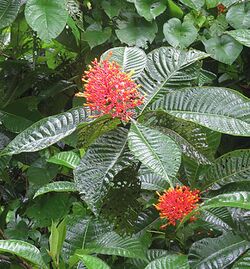Biology:Isertia
| Isertia | |
|---|---|

| |
| Isertia haenkeana | |
| Scientific classification | |
| Kingdom: | Plantae |
| Clade: | Tracheophytes |
| Clade: | Angiosperms |
| Clade: | Eudicots |
| Clade: | Asterids |
| Order: | Gentianales |
| Family: | Rubiaceae |
| Subfamily: | Cinchonoideae |
| Tribe: | Isertieae |
| Genus: | Isertia Schreb. |
| Type species | |
| Isertia coccinea | |
| Synonyms | |
Isertia is a genus of flowering plants in the family Rubiaceae. It contains 15 species of shrubs or small trees that are indigenous to the neotropics.[1] A few are cultivated as ornamentals.[2]
Systematics
Isertia was named by Johann von Schreber in 1789.[3] The generic name honors the German botanist and explorer Paul Erdmann Isert.[4]
Isertia is divided into two sections: section Cassupa and section Isertia. In section Cassupa, the fruit is a berry and the ovary usually has two or three locules. In section Isertia, the fruit is a pyrene and the ovary usually has five or six locules.[5]
Molecular phylogenetic studies have shown that Isertia is most closely related to Kerianthera, a monospecific genus from Amazonian Brazil .[6]
Species
- Isertia coccinea (Aubl.) J.F.Gmel.
- Isertia haenkeana DC.
- Isertia hypoleuca Benth.
- Isertia krausei Standl.
- Isertia laevis (Triana) B.M.Boom
- Isertia longifolia (Hoffmanns. ex Schult.) K.Schum.
- Isertia parviflora Vahl
- Isertia pittieri (Standl.) Standl.
- Isertia psammophila N.Dávila
- Isertia reticulata Britton ex Rusby
- Isertia rosea Spruce ex K.Schum.
- Isertia scorpioides B.M.Boom
- Isertia spiciformis DC.
- Isertia verrucosa (Humb. & Bonpl.) Standl.
- Isertia wilhelminensis Steyerm.
References
- ↑ "Isertia in the World Checklist of Rubiaceae". http://apps.kew.org/wcsp/qsearch.do?plantName=Isertia. Retrieved 19 April 2017.
- ↑ Huxley AJ, Griffiths M, Levy M, editors. 1992. The New Royal Horticultural Society Dictionary of Gardening. The Macmillan Press Limited, London; The Stockton Press, New York. ISBN:978-0-333-47494-5
- ↑ Schreber J (1789). Genera Plantarum Eorumque Characteres Naturales Secundum Numerum, Figuram, Situm, & Proportionem Omnium Fructificationis Partium. 1 (8 ed.). Frankfurt am Main, Germany. p. 234.
- ↑ Quattrocchi U (2000). CRC World Dictionary of Plant Names. 1. Boca Raton, New York, Washington DC, London: CRC Press. ISBN 978-0-8493-2675-2.
- ↑ Boom BM (1984). "A revision of Isertia (Isertieae: Rubiaceae)". Brittonia 36 (4): 425–454. doi:10.2307/2806603.
- ↑ Manns U, Bremer B (2010). "Towards a better understanding of intertribal relationships and stable tribal delimitations within Cinchonoideae s.s. (Rubiaceae)". Molecular Phylogenetics and Evolution 56 (1): 21–39. doi:10.1016/j.ympev.2010.04.002. PMID 20382247.
Wikidata ☰ Q6079734 entry
 |

